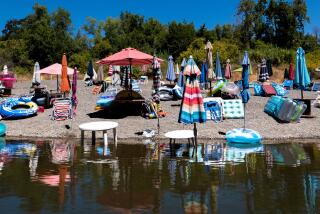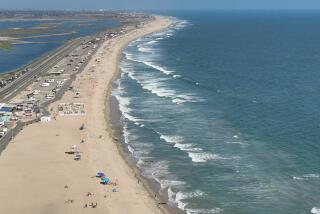Resort Was an Oasis for Blacks Until Racism Drove Them Out
- Share via
A small green park on the Strand in Manhattan Beach is dedicated to international brotherhood these days, but it began as a beach resort for black Angelenos that was destroyed by racism in the 1920s.
In its heyday during the 1910s and ‘20s, the resort was called Bruces’ Beach. It offered ocean breezes, bathhouses, outdoor sports, dining and dancing to hundreds of African Americans who craved a taste of Southern California’s good life.
Now the oasis is called Parque Culiacan. Since the 1970s, its name has signified the friendship between the California beach community and its sister city in Mexico’s Sinaloa state.
No sign in the parque recalls the history of Bruces’ Beach. No monument memorializes one of Manhattan Beach’s founders, developer-benefactor George Peck, or the beach resort’s black founders, Charles and Willa Bruce. When the Bruces built it, there were no resorts on Los Angeles’ coast that welcomed blacks.
Today, the resort endures only in books, in the memories of a few elderly townsfolk and in faded snapshots of happy summers and weekends. But yellowed clippings in scrapbooks and a 1956 thesis by a local resident, Robert L. Brigham, tell its story.
When Manhattan Beach was incorporated in 1912, with 600 residents, Peck flouted tradition and set aside a two-block area fronting the ocean between 26th and 27th streets and Highland Avenue for minority residents.
The Bruces, born during the Civil War in Union parts of the United States, were the first black Americans to buy lots. On their adjoining oceanfront lots they built the resort that bore their name. By 1919, four other black families owned cottages alongside white-owned lots.
Little is known about the Bruces. Census records of 1920 show that Charles Aaron Bruce had been born in Washington, D.C., and worked as a cook most of his life. Willa, who was sometimes known as Willie, had been born in Missouri. Their son, Harvey, was born in New Mexico about 1888 and had worked as a cook for the railroads.
In the 1920s, most Los Angeles real estate was bought and sold under racially restrictive covenants that had been enacted to keep neighborhoods white. Hotels, restaurants, beaches and parks barred blacks.
But Peck, who sold real estate out of a tent, helped the Bruces and their black neighbors build a fishing pier, all the while tossing out fistfuls of coins for black and white children along the boardwalk.
As coastal land became more valuable and Los Angeles’ black population increased--bringing more African Americans to Bruces’ Beach--so did whites’ hostility and racism.
The California Eagle, an influential black newspaper in Los Angeles, reported on July 4, 1924, that three blacks had been fishing off the Redondo Beach Pier when several members of the Ku Klux Klan handed them a pamphlet titled “Principles of KKK and Ideals of PURE AMERICANISM.”
In the margin of one of the pages someone had scrawled: “Colored Folks Beach three miles north”--in other words, telling them to move along to Bruces’.
Soon the Klan’s bigoted tentacles spread to Manhattan Beach.
Klansmen organized a 24-hour phone committee to intimidate and terrorize the Bruces anonymously. Blacks who ventured off the Bruces’ roped-off beach were harassed and insulted by hooded white men who slashed or let the air out of their tires. They also torched a house, set fire to a mattress under the Bruces’ deck, and posted “10 minutes only” parking signs. They burned a cross nearby.
When harassment failed to drive the Bruces and other blacks out of town, city officials condemned the neighborhood in 1924, ostensibly to build a park, although Live Oak Park was already nearby. Four percent of the city’s population petitioned against the condemnation, to no avail.
City officials tried pressuring the black property owners to sell at prices below fair market value. Four of the five families refused, including the Bruces, so the city attempted to seize the land under eminent domain.
Manhattan Beach officials insisted that the common good should take precedence over the interests of a few families who could easily and “equitably” be moved.
The Bruces and three other families sued, alleging racial prejudice. The Bruces demanded $120,000 in compensation--$70,000 for their two lots and $50,000 in damages--but specified that they really wanted the land, not the money. Another plaintiff asked for $6,500. They failed to stop the condemnation proceedings, but the judge put a crimp in the city’s complaint. He insisted that the ejected property owners had the right to purchase property elsewhere in the city, just not on the Strand. He said he would “throw the case right out of court” if the black families’ rights were not guaranteed. Although the resort was closed, black Angelenos continued to flock to Bruces’ Beach. Nearby, a City Council crony put up a “no trespassing” sign on city property, making it illegal to enter Bruces’.
In 1927, a black UCLA student, Elizabeth Cately, 19, was arrested for swimming and “trespassing” on the “private beach.” Manhattan Beach police refused to allow her even to change into dry clothes and kept her in jail for five hours.
Others, too, were soon arrested, and that’s when the National Assn. for the Advancement of Colored People stepped in. The lawyer for the NAACP got the City Council crony to admit the sign had been meant only to deter blacks, and the sign was removed.
The next day, the California Eagle’s banner headline crowed: “NAACP Wins Beach Victory.”
But the victory was short-lived. That same year, Bruces’ Beach Resort was razed, along with other cottages in the two-block area.
Pending a final legal resolution, the owners’ group held out for another two years before the city finally settled on payment. The Bruces received $14,500 and left the city. Other plaintiffs received between $2,000 and $4,000--as did their white neighbors.
All but the Bruces took the judge up on his order and purchased property elsewhere in town. But the only black beach resort in Los Angeles was history.
Black Angelenos began spreading their blankets on a blacks-only section of Santa Monica beach near Pico Boulevard called the Inkwell. It had been established in 1924.
Manhattan Beach didn’t rush to build its park; for almost three decades, the property remained vacant. In the 1950s, City Treasurer Lee Younggren estimated that the vacancy had cost the town about $80,000 in compensation fees and tax and assessment losses.
Finally, in the 1950s, the Manhattan Beach Recreation Commission began to worry that heirs of the former property owners might sue to regain their land unless it was used for the purpose for which it had been originally taken. The park was born.
More to Read
Sign up for The Wild
We’ll help you find the best places to hike, bike and run, as well as the perfect silent spots for meditation and yoga.
You may occasionally receive promotional content from the Los Angeles Times.






